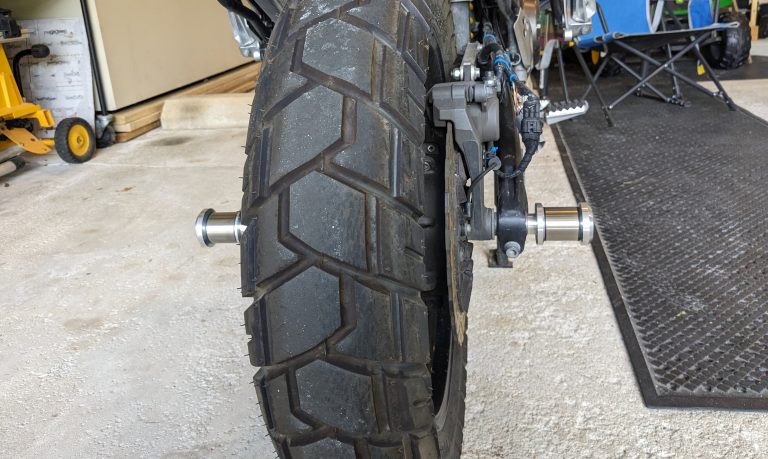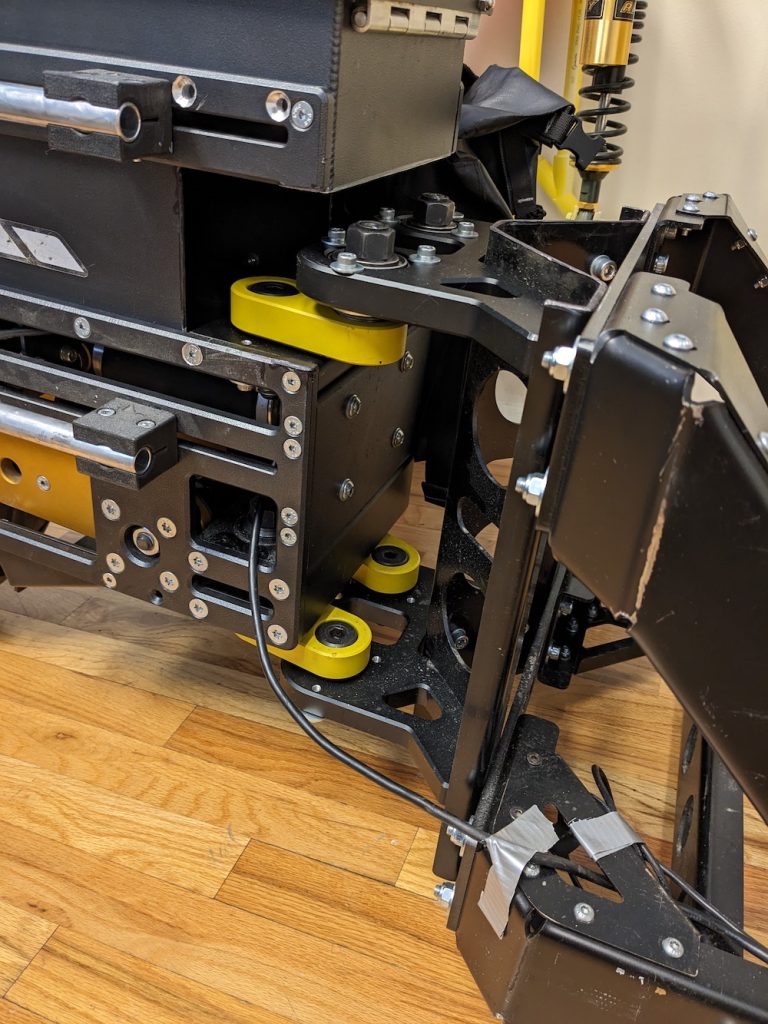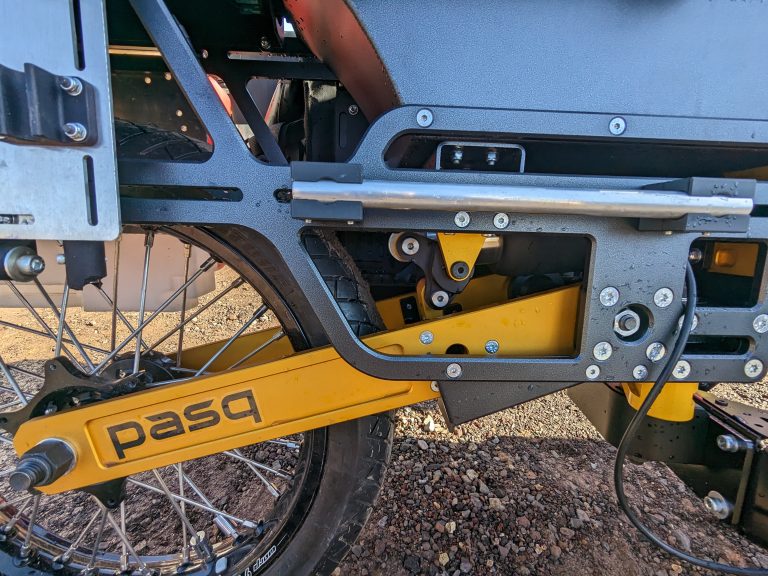Ultimate Guide to Single-Wheeled vs. Two-Wheeled Motorcycle Trailers
Pasq has set a goal of making the world’s best motorcycle trailer for adventure touring motorcycles. We’ll grant you that it’s a niche, but it’s a niche we intend to be the best at. Early in our research on how to make the trailer we wanted for ourselves for long-term traveling, we realized that if we wanted to make the best, it would have to be a single-wheeled trailer.
Last summer we showed our ADV1 single-wheeled motorcycle trailer prototype at several rallies and expos. We fielded a zillion questions, but the one that we were expecting the most, we did not hear all that often:
“Why a one-wheeled motorcycle trailer, and not two?”
I wondered why we didn’t hear it all that often. I expected heated debates on single-wheeled trailers vs two-wheeled. But it didn’t come up very frequently. I eventually came to the realization that when people see a well made, professionally designed one-wheeled motorcycle trailer, it’s self-evident why one wheel is better than two. However, for those of you who have not seen our prototype or watched any of our videos, you may still want an explanation why we built a one-wheeled trailer. So, let’s dive into some of the details on that decision.
Motorcycle Handling With Single-Wheeled vs. Two-Wheeled Trailers
There are three main states of motorcycle riding: 1) Going straight or nearly straight. 2) Slow speed maneuvering by steering with your handlebars. 3) Higher speed turning by leaning. How does a trailer impact each of these?
Well designed and well made trailers don’t really impact the handling of a motorcycle going straight and doing slow speed maneuvering, no matter if they have two wheels or one. However, the physics of a two-wheeled trailer just don’t make sense when being pulled by a leaning motorcycle going around a curve.

The above drawing should make it pretty clear what happens when you go around a curve. A two-wheeled trailer’s momentum (weight x speed) tries to continue forward. The wheels don’t turn, nor do they lean. They try to go straight. That means the trailer is trying to push the back end of the motorcycle off the road.
This is mainly an issue when a rider goes into a corner a little too fast and is braking at the beginning of a curve. Under braking, while leaning into a curve, more of the weight of the bike is moved to the front tire and less to the rear. Add to this uncomfortable situation the weight of a trailer trying to push your back tire off the road, and you have to just hope for the best.
It’s quite similar to trying to brake in a turn with a passenger (pillion) on the back who is squirming around and leaning in the wrong direction.
The Pasq ADV1 leans with your bike and its tire follows your bike’s line perfectly through the turn. There is no pushing in the wrong direction. If you do go into a corner too fast and are braking, the weight you’re carrying on the ADV1 will also need to slow down, but that weight is not trying to push you off the road…it’s following your line through the turn. Going back to the pillion analogy, the ADV1 is like having a perfect pillion that is leaning perfectly with you and not squirming. You do feel the weight, but it’s not fighting you.
Emergency Swerving/Handling
The topic of emergency swerving is very similar to the handling issue, but with one additional factor: hitting the obstacle you’re trying to avoid.
When, inevitably, a motorcycle rider needs to quickly swerve to avoid a pothole or any other obstruction in the road, the physics of a two-wheeled trailer again work against what the rider has to do. The trailer is trying to keep the motorcycle from returning to the proper lane, pushing the bike in the direction of the initial swerve.
The bad situation is compounded by having wheels protruding out past the width of the bike. Unless the rider is able to swerve very far away from the obstruction, the trailer’s wheel is going to hit whatever is being swerved around. Depending on the size of the hole or object, this could mean real trouble with the trailer bouncing and jerking the bike around.
And just like in the handling explanation above, none of this is an issue for the Pasq ADV1. The trailer leans and follows the path of the bike. The ADV1’s tire follows the same path as the bike’s tires, and the width of the trailer is about the same as the bike, so if the rider misses the obstruction with the bike, the ADV1 will miss it as well.
Off Road Ability
The ADV1 has 6.5” of suspension travel and a 17” ADV-specific wheel and tire. It is designed to go nearly anywhere a mid-sized or large ADV bike can go. This includes interstates/expressways, dirt roads, and even single-track trails that aren’t too advanced. (Please note, the ADV1 is not designed for lightweight enduro bikes and technical trails.)
Two-wheeled trailers can handle smooth dirt roads, but once the road turns to potholes or washboards, these trailers begin to have problems. And, of course, forget about doing any single-track trails with them.

Wind Resistance/Gas Mileage
The ADV1 is narrower than all of the two-wheel motorcycle trailers we’ve seen, which means more of it sits inside the slipstream of the bike and rider. Much of two-wheeled motorcycle trailers sits outside the slipstream and is buffeted by the wind.
This is important for two reasons:
- Unequal buffeting (side winds, for example) can cause handling problems with a two-wheeled trailer. Although side winds impact the ADV1 as well, they are not compounded by the bike’s slipstream hitting the trailer head on.
- Constant wind buffeting on the trailer means a fairly large impact to gas mileage with a two-wheeled trailer. In our testing, a loaded ADV1 reduces your gas mileage a small amount (1 or 2 mpg) more than having a pillion.

Weight of a Two-Wheeled Trailer vs. a One-Wheeled Trailer
The ADV1—including the wheel and tire—comes in at about 85 lbs (39 kg) unloaded. We have no idea what some of the two-wheeled motorcycle trailers out there weigh, but we are going to go out on a limb and say they weigh more than 85 lbs. Much more.
Consider that a pair of metal panniers and their mounts weigh around 36 lbs, give or take, depending on the make and model. Trade your metal panniers in for soft bags or even inexpensive, flexible dry duffle bags and the weight of the ADV1 is fairly inconsequential. However, if you’re in love with your Jesse Luggage (which we totally understand) you are at a minimum saving all the mounting hardware.
Carrying Capacity
It’s easy to imagine a two-wheeled trailer would have more capacity than the ADV1 single-wheeled trailer. However, when you consider that an ADV1 has internal, dry, lockable storage of 22 liters, and it can carry up to four normal motorcycle panniers and a dry duffle on top, you begin to to get to a total of 230 to 260 liters of storage capacity in just that one configuration. And of course there are many other configurations possible, including only dry bags, dry bags and bicycles, and on and on.
Lastly, the ADV1 is engineered to carry up to 120 lbs (55 kg) which is a considerable amount of gear.
Lane Splitting/Filtering
If you live in California, Montana, or Utah in the US, or if you live in any of the many countries around the world that allow lane splitting (also called lane filtering), a single-wheeled trailer has one obvious advantage. The picture below says it all. You can split/filter with the ADV1, but it’s not likely with a two-wheeled trailer

Tire Selection
Most two-wheeled trailers (and even most one-wheeled trailers) have odd-sized wheels, which makes it difficult to find tires. We opted, for many reasons (we will discuss this in a future blog post), to use a 17” x 2.5” ADV wheel. One reason for that decision was to give our customers the maximum number of tire options.
No matter if you are—like us—in Chicago, or in Nairobi, in the middle of your North Cape to Cape Town adventure, you’re going to be able to find a tire that fits the ADV1.
Is Single-Wheel Trailer Superior in All Ways?
So, are we saying the ADV1 is superior in every way to a two-wheeled trailer? Of course not—nothing is perfect. There are always trade offs. There are a few areas where the ADV1 has challenges a two-wheeled trailer doesn’t, and there are areas where it is a draw. Let’s take a look at a few:
Tongue Weight
Tongue weight is the amount of weight a trailer puts downward on a tow vehicle. The common best practice for two-wheeled trailers is that most of the weight should be near the axle, and 60% of the weight should be in front of the axle. This provides stability and reduces the chances of the trailer wagging or whipping around behind the tow vehicle.
We will go into this in more detail in a later blog post, but our patent pending trapezoid hinge (gif of our working prototype below) means that tongue weight does not impact handling in the same way it does for any trailer without a trapezoid hinge. Nevertheless, we have moved our wheel inside of our trailer frame. This allows for a more balanced trailer front-to-back, and less tongue weight than on all other single-wheel trailers on the market.

It’s also important to point out that the ADV1 attaches to the bike’s rear axle, which means the tongue weight does not rest on the bike’s suspension.
Conclusion: Very different, but we’ll say it’s a Draw
Backing Up
Backing up a motorcycle is never fun, even without a trailer. This is especially true if you have to back up an upward incline. With a one-wheeled trailer, the rider has to balance both the bike and the trailer as they back up. It’s not as difficult as it sounds, but it does add some complexity. Anyone who can back up a trailer with a four-wheeled vehicle is going to be able to back up the ADV1 as well. We have actually gotten quite good at it, but we do a lot of planning of where we stop to make sure we don’t have to do it very often!
Conclusion: Two-Wheeled Trailers Win, but not by Much
Standing When Off the Bike
This is a non-issue for a two-wheeled trailer—it won’t fall over! In our testing of the ADV1, the side stands on BMW 1250 GSs, Yamaha Super Teneres, Harley Pan Americas, and KTM Adventures are able to hold the bike and the loaded ADV1 upright when the side stand is on solid ground. And any bike with a center stand is able to hold the ADV1 upright with no problems.
However, the ADV1 is going to come with a stand that acts as a side stand when the bike is on its side stand, and our same stand will work as a center stand when the ADV1 is not connected to a bike. Furthermore, our center stand allows the ADV1 to act as a table for your basecamp with all of your buddies!
Conclusion: A Draw Due to Our Design
One Wheel to Rule them All
When you take all of this information into consideration, it seems to us that a well engineered, well built, one-wheeled motorcycle trailer is the clear winner over two-wheeled trailers. And this is especially true if that one-wheeled trailer is the Pasq ADV1. The ADV1 was designed from the beginning to do everything an ADV bike will do, and that means it’ll go to the nearby state park for the weekend, or it’ll give you many more options as you make your way to Prudhoe Bay, Alaska or Tuktoyaktuk, Canada.






